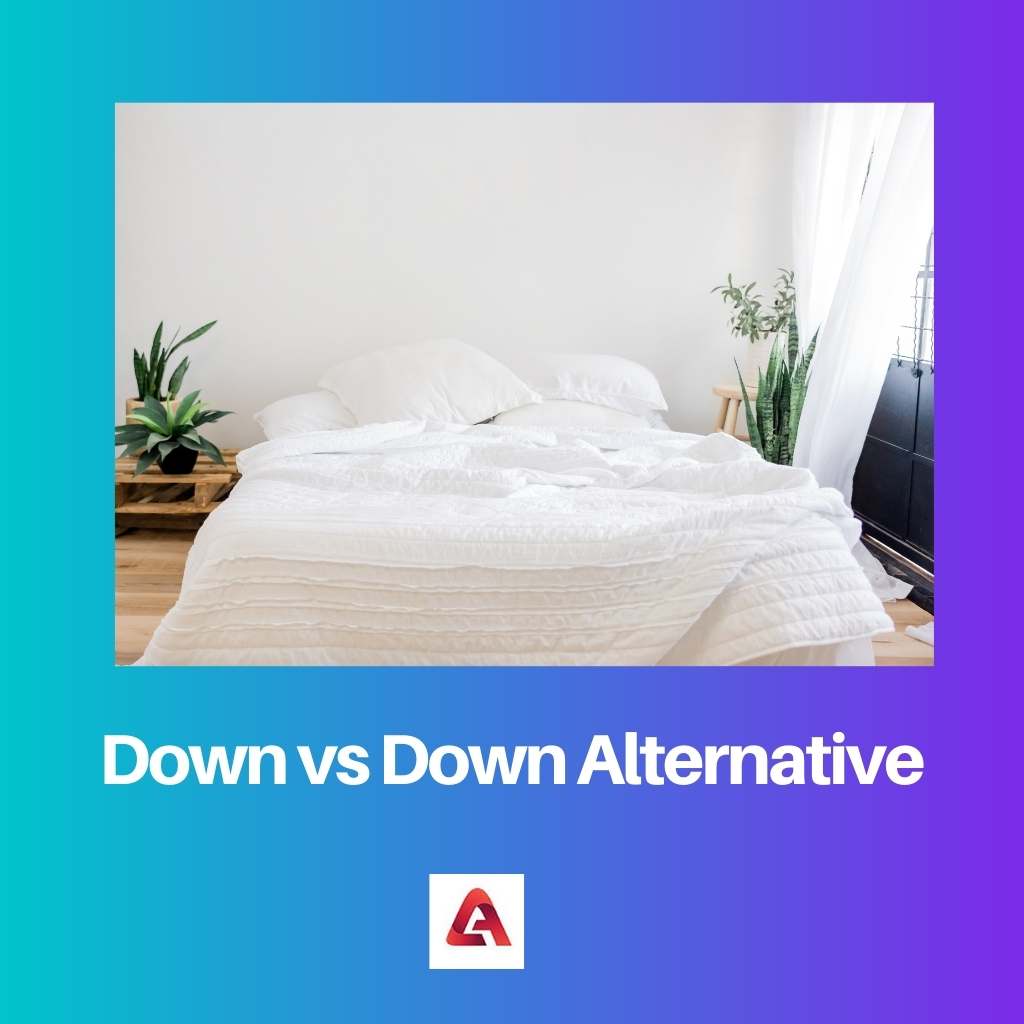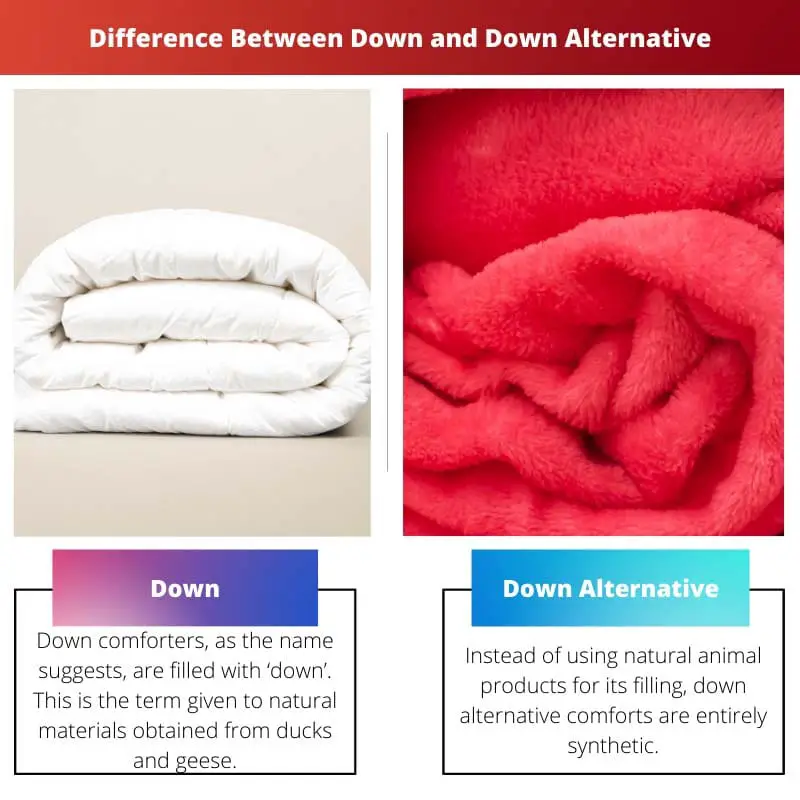The market for comforters has left no stone unturned when it comes to variety in their shapes, sizes, and design.
Out of these, down and down alternatives are two similar-looking comforters, but they have quite a few differences. Knowing them can make it easy to shop for this product.
Key Takeaways
- Down is a natural material made from the feathers of geese or ducks, while down alternative is a synthetic material made from polyester fibers.
- Down is more breathable and insulating than down alternative, while down alternative is hypoallergenic and easier to care for.
- Down is more expensive than down alternative due to its natural sourcing, while down alternative is more affordable.
Down vs Down Alternative
The difference between down and down alternatives is that down comforters have a natural filling of feathers which are obtained from ducks and geese, whereas down alternative comforters have a synthetic filling of cotton, polyester, or other materials. This makes down comforters fluffier, softer, and more comfortable as compared to the latter.

Down comforters are fluffy and cloud-like, which is the perfect option for those who prefer softer comforters to sleep in. It surely has a warm effect, but a person using it does not get sweaty as it has sufficient breathability.
Moreover, it is a very durable and long-lasting product. However, its expensive price compensates for the same.
Down alternative comforters are not as fluffy as the former but are suited for people who may have allergies. It is not as breathable as down comforters but can work well in extremely cold environments.
Many people find it to be the more ethical option as it is fully synthetic and does not cause any harm to animals. Moreover, it is way cheaper than down comforters.
Comparison Table
| Parameters of Comparison | Down | Down Alternative |
|---|---|---|
| Filling | Down comforters are filled with natural feathers obtained from ducks and geese. | Down alternative comforters are filled with synthetic materials such as cotton and polyester. |
| Comfort | They are fluffy, soft, and very comfortable. | They are not as fluffy and comfortable as the former. |
| Breathability | They have more breathability. | They have less breathability. |
| Durability | They are more durable. | They are not as durable as the former. |
| Cleaning | It is difficult to clean them as they cannot be washed in a washing machine. | It is easier to clean them as they can be put into a washing machine. |
| Allergies | People may have allergies to the product. | People are less likely to have allergies to the material. |
| Cost | These comforters are very expensive. | These comforters are relatively cheaper. |
What is Down?
Down comforters, as the name suggests, are filled with ‘down’. This is the term given to natural materials obtained from ducks and geese.
Down comforters are filled with their feather, because of which they are fluffy and very comfortable as compared to others. However, many people may have allergies to this product.
This kind of comforter is extremely breathable by dint of the materials used to manufacture it. So, they are pretty warm and do not make it extremely hot for the person using them.
Moreover, it is very durable and long-lasting. However, a downside of the comforter is that it is quite difficult to clean it. It cannot be thrown into a washing machine.
Regardless, most users claim that the comfort it offers is worth the price, which is very expensive, just to be clear.
The price range depends on the quality and manufacturer, but most of these are costlier than other comforters available in the market. The price can vary according to the fill power as well.
However, many people also criticize down comforters as being unethical. This is because they use animal products for their filling, which may cause harm to ducks and geese.
What is Down Alternative?
As the name suggests, an alternative down comforter is an alternative for down comforters. Instead of using natural animal products to fill, alternative comforts are entirely synthetic.
Cotton and polyester are used to manufacture them. However, they may not be as fluffy and comfortable as the former.
Another downside is they have less durability and are not as long-lasting. However, they can be cleaned easily using a washing machine and dryer.
They are not as breathable as down comforters, which makes them suitable for colder conditions. However, the product’s price is much lower and more affordable.
People are even less likely to develop an allergy to its synthetic material. However, it should always be checked for its filling, as some may even be allergic to cotton and polyester.
Nonetheless, down alternative comforters are considered to be an ethical choice. This is because they do not use any animal products for manufacturing.
Most hotels and places with beds have down alternative comforters. This may be primarily because of how affordable it is. But it is also better to avoid adverse health reactions that may sometimes even be life-threatening.
Hotels that do not use these comforters are responsible for keeping their guests informed.
Main Differences Between Down and Down Alternative
- Down comforters are filled with natural feathers obtained from duck and geese, whereas down alternative comforters are filled with synthetic materials such as cotton and polyester.
- Down comforters are fluffy, soft, and very comfortable, whereas down alternative comforters are not as fluffy and comfortable as the former.
- Down comforters have more breathability, whereas down alternative comforters are not as breathable.
- Down comforters are more durable, whereas down alternative comforters are not as durable.
- Down comforters are difficult to clean, whereas down alternative comforters can easily be thrown into a washing machine.
- Down comforters may cause allergies, whereas down alternative comforters are relatively safer to use.
- Down comforters are very expensive, whereas down alternative comforters are relatively cheaper.


The comparison of down and down alternative comforters is presented in a clear and organized manner, facilitating an understanding of the key differences between these two types of bedding. It serves as a helpful resource for those in search of suitable comforters.
The article provides a comprehensive comparison of down versus down alternative comforters. It gives a clear explanation of the key differences between the two types of comforters and their respective advantages and disadvantages.
The detailed explanation of both down and down alternative comforters provides valuable insights for potential buyers. It covers various aspects such as comfort, breathability, durability, and allergens, which are crucial factors to consider when choosing a comforter.
The comparison table offers a concise overview of the distinctions between down and down alternative comforters in terms of filling, comfort, breathability, durability, cleaning, allergies, and cost. This allows readers to easily assess their options based on specific preferences and requirements.
The article provides insightful comparisons between down and down alternative comforters, elucidating their respective characteristics and benefits. It is a useful guide for consumers seeking to understand the nuances of different types of comforters available in the market.
The article offers an in-depth examination of the characteristics and qualities of down and down alternative comforters, enabling readers to make well-informed decisions based on their individual needs and preferences.
The article effectively outlines the differences between down and down alternative comforters, shedding light on their filling, comfort, breathability, durability, cleaning process, allergies, and cost. It’s a helpful guide for consumers looking to make an informed purchase decision.
The comprehensive analysis of down and down alternative comforters equips readers with valuable knowledge to determine the best option for their personal requirements. The detailed breakdown of attributes such as filling, comfort, breathability, durability, cleaning, allergies, and cost is highly informative.